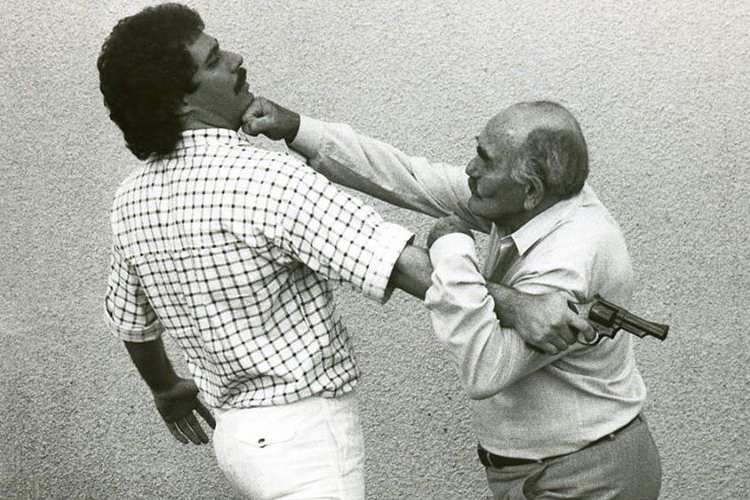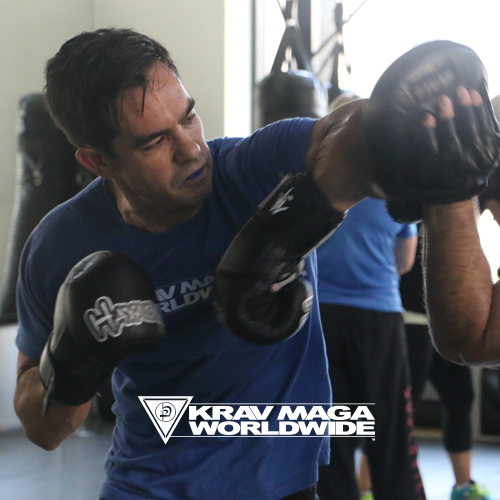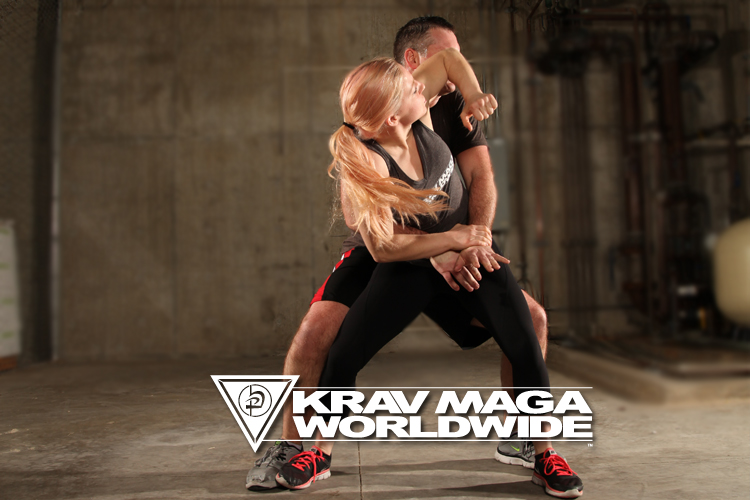Krav Maga Striking - Elbows
Krav Maga Worldwide® self-defense is a system that was developed in Israel for the purpose of training military personnel serving in the IDF. The system’s creator, Imi Lichtenfeld, immigrated to the newly established nation of Israel at the end of WWII. He was an experienced boxer, grappler, and Nazi resistance fighter.
Imi’s experience and teaching ability put him in a position to lead the bourgeoning Israeli Defense Forces as an instructor and develop a system that taught ordinary people, who were also immigrating to Israel, to become proficient in hand-to-hand combat in a very short period of time.

A system that adapts.
He recognized the need to have a system that was adaptable based on what was effective and what was not.
To this day, the Krav Maga Worldwide® system is analyzed and refined to maintain effectiveness and maximize a student’s ability to defend themselves in a given situation.
Basically, if a technique doesn’t hold up as effective, easy to learn, and easy to recall under stress, it is eliminated from the system.

Combatives
Striking techniques or “combatives” are the root of the Krav Maga Worldwide® self-defense system. In order to effectively defend themselves a person must know how to strike and do damage to anyone who would try to do damage to them.
One of the most effective and powerful tools to use in striking is the elbow. Elbow strikes are short range combatives that can be used to make damage in different directions and on different planes of movement.
There are seven fundamental elbow strikes that Krav Maga Worldwide® students learn in Krav Maga Level 1. Elbow strikes aren’t always made with the very tip of the elbow, or thrown at one specific target so learning a variety of elbow strikes and how to generate power with them is incredibly important in Krav Maga striking.
These strikes become essential, valuable, tools as students progress in the system, apply them to different situations, and utilize them based on different tactics.
Elbow #1
Elbow #1 is essentially a straight punch delivered with the elbow. It’s probably the first technique that comes to mind when someone thinks about making an elbow strike. The strike travels forward on a horizontal plane, just like a straight punch.
When the space between the striker and the opponent becomes very close, a straight punch is not going going to have the distance needed to generate power in the fist.
With a punch, the striker’s fist is traveling at the highest velocity but with limited space we shorten the weapon by bending the arm and dropping the fist about chin/throat level so that the elbow is now traveling at the highest velocity.


Mechanics
When Elbow #1 is made with the striker standing, the body mechanics are the same as a straight punch. The hips and shoulders rotate to generate power, and the elbow goes straight ahead.
If possible, the striker should take a slight step at an angle in order to bring the elbow strike in line with high value targets like the eyes, nose, mouth, or jaw. The striking surface used in Elbow #1 isn’t entirely the tip of the elbow, or where the elbow bends. It’s also just below the elbow and part of the forearm.
Elbow #1 can also be used and be effective on the ground whether the defender is in a top position like full mount, knee-on-belly, or side-control. It can also be thrown if the defender is on their back and fighting to get up or maintain some control and do damage while holding the opponent in guard.
Elbow #2
When dealing with an opponent who is not directly in front, it’s important to know how to make damage to the side and when transitioning/turning in to face the opponent. Elbow #2 is an elbow that is thrown to the side and, again, on the horizontal plane. Body mechanics don’t really allow for punches that use the knuckles as the striking surface to be thrown sideways so Krav Maga striking teaches students to use hammerfists to the side and elbows to the side.
When delivering Elbow #2, the target will be to the side of the striker in what is basically a strategically superior position so it’s important that we bring the elbow up to make the strike so we are covering our face and the soft targets below the eyebrows.
Mechanics
To deliver the elbow the striker shifts their weight to the side that the strike is going and rotates the hips and shoulders in that direction. If possible a small step in that same direction will help with the weight shift and add power to the strike.
The striking surface for Elbow #2 can be the very point of the elbow or the perimeter around the point of the elbow. If the soft targets of the opponent’s face are open to strike, it’s always good to target them. Otherwise the elbow can basically be thrown at whatever target is available ie, the chin, the throat or neck, as a means of both making damage and creating space needed to transition and turn in.
The defender should keep their elbow high here to provide some protection for their face especially considering that the attacker or opponent is already to the side and in a better position to make damage. It might already be the case that the defender has been struck or grabbed from the side before realizing that an assault is occurring so getting the elbow up to protect the face is super important.
Elbow #3

In the same way that dealing with an opponent to the side is a disadvantageous position, defending against an opponent who is attacking from behind is even worse. Elbow #3 is an elbow thrown on the horizontal plane, to the rear of the defender as a means of making damage to an opponent who is behind and/or transitioning to face that opponent.
The striking surface for Elbow #3 is the point of the elbow and/or the lower part of the triceps close to the point of the elbow.
Details
Similar to Elbow #2, we look to strike the soft targets of the opponent’s face, that is anything below their eyebrows. If those targets aren’t open or available, striking the chin, the throat, the base of the neck, can be effective at causing some damage to the opponent and creating space to transition to face.
Just like with Elbow #2 the idea is that we are dealing with an opponent who is not in front, so the defender getting their elbow up high to protect their face and send the strike is important.
Elbow #4
Elbow #4 goes low and behind. Imagine if someone grabbed you in a bearhug with your arms encircled inside of theirs. There aren’t a whole lot of options for striking here but shooting your elbow directly back and into the attacker or opponent’s midsection, ribs, stomach is a viable and effective way of making some amount of damage as well as creating space.
Throwing Elbow #4 is basically throwing your entire bent arm back and into the attacker or opponent. The striking surface is going to be both broad and long and the idea is to aggressively strike whatever part of the attacker or opponent’s body is available.
Throwing Elbow #4 multiple times might cause the opponent to double over or at least get their hips back. If the strike creates enough space it’s possible to then transition to Elbow #3 and turn in…or to transition to Elbow #5.
Elbow #5
Elbow #5 is an arcing/rising elbow that goes up and back, like a backward uppercut with the elbow and maybe part of the triceps between the elbow and shoulder. It’s a pretty situationally specific strike.
The idea is to come up and through the face, head, and or neck of an attacker or opponent who is directly behind and has been doubled over by strikes to the midsection, or possibly short heel strikes up to the groin. Elbow #5 can also be used if the defender has been folded or doubled by the weight of the attacker behind them.
The intent is to be striking up and backward with the elbow. This sort of strike can be used from a standing position or if the fight has gone to the ground.
Elbow #6
The best way to describe Elbow #6 is an uppercut punch with the elbow. It’s sort of the polar opposite strike of Elbow #5 and would be thrown when dealing with an opponent who is in front of the defender as opposed to behind. Similar to Elbow #1, Elbow #6 can be used when their isn’t space for a strike with the actual hand/fist/knuckles.
In smaller spaces it’s better to use shorter weapons so we shorten the arm by keeping the elbow bent and send the strike as if we were running our hand through our hair on the side of our head. The striking surface for Elbow #6 is the same as Elbow #1, the tip of the elbow and part of the forearm below. Ideally the strike would target the chin, mouth, nose, eyes/eye sockets of the attacker or opponent.
Elbow #6 can be thrown very effectively from the feet or, in a less ideal scenario, if the defender is on their back and throwing strikes up at an attacker or opponent who is on the ground with them.
Elbow #7
Elbow #7 is delivered by dropping the point of the elbow straight down. Think of it as an elbow that goes from 12 o’clock to 6 o’clock. Similar to Elbow #4 and #5 it’s somewhat specific in that the opponent is generally going to have to be lower than the defender.
To get power into the elbow the defender throws it by level-changing with the legs to drop their weight and rotating the hips and shoulders to basically slam the point of their elbow and the forearm or triceps straight down onto the opponent or attacker. It’s very similar to a downward hammerfist, but with the elbow.
With Elbow #7, if it’s being used while the defender is on their feet, the idea is to target the back of the opponent’s head, the back of their neck, or top of of their spine where it connects to their neck. This strike can be used on the ground as well, whether the defender is in a top position like full mount or even from off of their back.

Train to be effective with elbows.
There’s a saying in Krav Maga about elbows, and that is “elbows finish fights”. It’s true. Elbows are very powerful short range combatives and can cause a great deal of damage very quickly.
Aside from the concussive elements involved with elbow strikes, the elbow itself is bony, pointy, and can easily cause cuts and lacerations. Being effective at throwing elbows in all seven directions is a foundational skill in Krav Maga. Elbows are essential in being able to defend yourself in myriad self-defense situations.
They are a huge factor in choke defenses, bearhug defenses, weapons defenses, ground fighting…just about any scenario or situation in which distance is going to close between attacker and defender.
Krav Maga Worldwide
The best way to learn this skill is by training at a Krav Maga Worldwide® certified training center. Krav Maga Worldwide certified instructors know how to teach these techniques and bring students to a high level of proficiency with them in a short period of time. Start training with us today and you’ll be better prepared to defend yourself. You can check out a FREE trial class at our HQ Training Centers in Los Angeles by filling out our contact form.
If you aren’t in Los Angeles, fill out the contact form and we’ll forward your information to the certified training center closest to you…or you can look for the closest location to you by checking out our searchable map here.
